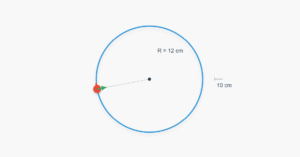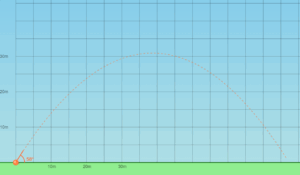Motorboat Velocity Simulation
This simulation demonstrates the resultant velocity of a motorboat moving north at 25 km/h while experiencing a water current of 10 km/h at 60° east of south.
The resultant velocity is calculated using vector addition with the parallelogram method.
Example
Question:
A motorboat is racing towards north at \(25\,\mathrm{km/h}\) and the water current in that region is \(10\,\mathrm{km/h}\) in the direction of \(60^\circ\) east of south. Find the resultant velocity of the boat.
Solution:
Let \(\vec{v}_b\) represent the velocity of the boat and \(\vec{v}_c\) the velocity of the water current.
Using the parallelogram method, the magnitude of resultant \(\vec{R}\) is found using the law of cosines:
\[
R = \sqrt{v_b^2 + v_c^2 + 2 v_b v_c \cos 120^\circ}
\]
\[
= \sqrt{25^2 + 10^2 + 2 \times 25 \times 10 \times \left(-\frac{1}{2}\right)} = \sqrt{625 + 100 - 250} = \sqrt{475} \approx 21.8\,\mathrm{km/h}
\]
For the direction, use the law of sines:
\[
\frac{R}{\sin\theta} = \frac{v_c}{\sin\varphi}
\]
or,
\[
\sin\varphi = \frac{v_c \sin\theta}{R}
\]
Here, \(\theta = 60^\circ\):
\[
\sin\varphi = \frac{10 \cdot \sin 60^\circ}{21.8} = \frac{10 \cdot (\sqrt{3}/2)}{21.8} \approx \frac{8.66}{21.8} \approx 0.397
\]
\[
\varphi = \arcsin(0.397) \approx 23.4^\circ
\]
Thus, the resultant velocity of the boat is about \(21.8\,\mathrm{km/h}\) at an angle of \(23.4^\circ\) east of north.
Resultant Velocity
Magnitude: 22.0 km/h
Direction: 0.0° east of north



